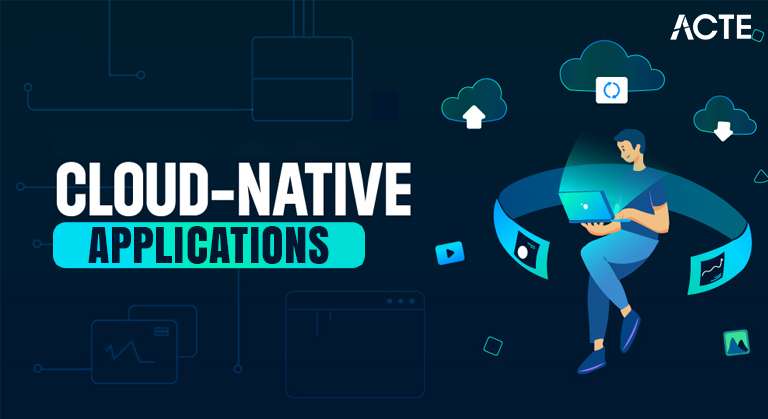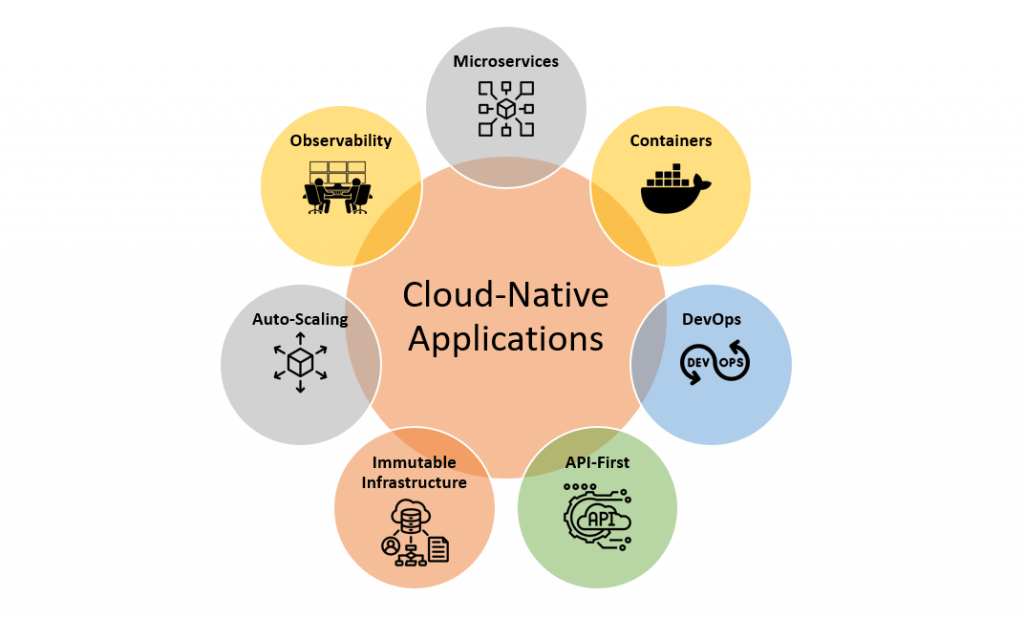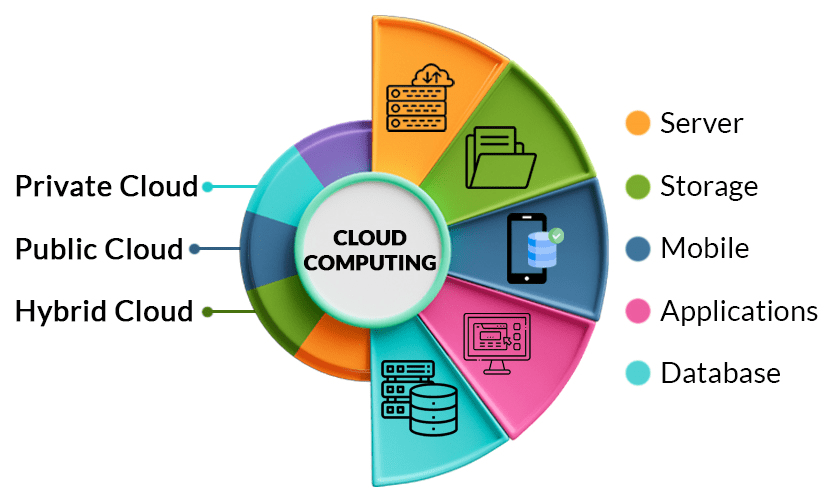
- Introduction to Cloud-Native Applications
- Key Technologies for Cloud-Native Apps
- Core Principles of Cloud-Native Development
- Benefits of Cloud-Native Applications
- Challenges in Building Cloud-Native Apps
- Future of Cloud-Native Applications
- Best Practices for Cloud-Native Development
- Conclusion
Introduction to Utility Computing
Cloud-native applications are software systems that are designed from the ground up to run and thrive in cloud environments, taking full advantage of the potential of cloud platforms such as AWS, Azure, or Google Cloud. In contrast to traditional applications that are often built for on-premise infrastructure, cloud-native apps are built from the ground up with cloud principles in mind, enabling flexibility, scalability, and resilience, which are key concepts taught in Cloud Computing Courses to prepare professionals for building and managing cloud-native applications. Most of these applications usually employ recent cloud technologies, including containerization, microservices, and CI/CD pipelines, to achieve better efficiency and less downtime. Building cloud-native applications means developing applications that are dynamic and adaptable, capable of scaling on demand and easily integrating with other services within the cloud ecosystem. Cloud-native applications are designed to provide seamless user experiences, high availability, and rapid development cycles in a manner that allows the application to evolve in line with changed business requirements. Cloud-native development has become a fundamental approach for organizations seeking to maximize the advantages of cloud platforms such as cost-efficiency, faster time-to-market, and better resource management.
To Explore Cloud Computing in Depth, Check Out Our Comprehensive Cloud Computing Online Course To Gain Insights From Our Experts!
Key Technologies for Cloud-Native Apps
Cloud-native applications use a variety of technologies and tools that allow developers to build, deploy, and manage scalable and resilient applications in cloud environments. The technologies are built to take advantage of the capabilities of the cloud, making applications more efficient, flexible, and fault-tolerant. The key technologies are:
- Containers: Containers are lightweight, portable units of software that contain the application and its dependencies. Containers enable developers to build applications that run identically across environments-from local development machines to cloud platforms. The most popular tool for containerization is Docker.
- Kubernetes: Kubernetes is an open-source container orchestration platform that automates the deployment, scaling, and management of containerized applications. It makes cloud-native applications scale on-demand and manage containers effectively, which ensures high availability and resilience.
- Microservices: Microservices architecture breaks up the application into smaller, self-contained services that can be developed, deployed, and scaled independently, similar to how An In-Depth Exploration of Content Delivery Networks discusses breaking down content into smaller, distributed parts for efficient delivery and scalability. Each microservice runs a specific business function, which makes it easier to update or replace individual components without affecting the whole system.
- Serverless Computing: Serverless computing is when developers can develop and deploy applications without worrying about the infrastructural part of things. Here, cloud providers such as AWS Lambda, Azure Functions, and Google Cloud Functions automatically scale applications based on demand. Here, businesses can focus on the code and functionality rather than doing server management.
- CI/CD Pipelines: CI/CD allows application updates to be implemented faster and more securely. Jenkins, GitLab CI, and CircleCI are tools for automating tests, integrations, and releases, which ensures rapid and safe movement of code changes into production.
- Service Meshes: For example, a service mesh like Istio provides the orchestration of communication between microservices. It handles load balancing, service discovery, and fault tolerance without altering the code of the application, making interactions among various other microservices in a cloud-native environment run gracefully and smoothly.
- Scalability: Cloud-native applications are designed to scale horizontally, meaning they can automatically adjust to increased demand. This scalability ensures that the application remains responsive and cost-effective, even during traffic spikes or heavy workloads.
- Faster Time-to-Market: Cloud-native development fosters microservices, containers, and CI/CD pipelines, making the entire developmental, testing, and deployment process more streamlined than ever. It allows developers to develop and deliver new features and updates on time to keep up with customer demand and deadlines.
- Cost-Efficiency: Cloud-native applications take advantage of the elasticity offered by the cloud. Organizations need to pay for only the required resources, thus scaling up and down according to traffic demands, which can be efficiently managed through Creating and Understanding Docker Images to ensure that applications are portable, scalable, and optimized for cloud environments. This pay-as-you-go model saves a significant amount of costs as compared to traditional infrastructure.
- High Availability and Resilience: Cloud-native applications are designed to be fault-tolerant. Auto-healing mechanisms, redundancy, and failover strategies often ensure high availability even in case of system failure or resource scarcity.
- Flexibility and Agility: The modular nature of cloud-native applications allows organizations to quickly iterate and experiment with new features. Developers can independently update or replace microservices without affecting other parts of the application, promoting agility and reducing the risk of downtime.
- Enhanced Security: Cloud-native applications can employ advanced cloud-based security features including identity and access management, encryption, and security patches that automate. This results in an assuredly secure and compliant application. In essence, cloud-native applications offer agility, scalability, and resilience needed to succeed within a fast-changing digital environment.
- Complexity in Architecture: The microservices architecture that underpins cloud-native apps can introduce complexity. Each microservice must be independently developed, deployed, and maintained, requiring careful coordination and management. This complexity increases the overhead for developers and operations teams, particularly when managing a large number of microservices.
- Service Communication: In a cloud-native app, services have to communicate with each other flawlessly. However, it becomes difficult to manage communication between a large number of services, especially when they are spread across multiple containers or environments. Service meshes and API gateways help manage the complexity, but this comes at the cost of extra configuration and maintenance.
- Data Management: The distributed nature of data in cloud-native applications, where it is spread across various services and storage systems, poses a challenge in maintaining consistency, reliability, and availability of such data in the event of network failures or scaling events, a challenge that can be addressed by Understanding Azure Tenants Definition and Overview, which helps in managing resources, security, and data consistency within a multi-tenant cloud environment.
- Security: Even though cloud platforms provide a number of robust security features, security for cloud-native applications is ensured by careful planning and execution. Multiple microservices, APIs, and data sources add complexity to security across the entire application, which can be challenging to monitor continuously, scan for vulnerabilities, and enforce access controls.
- Operational Overhead: Managing cloud-native applications can be operationally resource-intensive. Monitoring, logging, and troubleshooting tools are crucial to ensure applications remain performant and reliable, but the number of components involved in a cloud-native architecture can be operationally very overhead-intensive for teams.
- Skills Gap: The technical skills needed for cloud-native development include mastering the techniques of containerization, orchestration, and microservices design. Finding a qualified developer or DevOps professional with the right experience to build and maintain such a complex system may be difficult for organizations.
- Use Microservices Architecture: Breaking up applications into small, independent services provides more flexibility, scalability, and fault tolerance. In a microservices architecture, one microservice should be able to handle only a specific business function for better maintenance and easier updates.
- Containers and Orchestration: Containers provide consistency across development, testing, and production environments, and container orchestration platforms like Kubernetes help manage and scale these containers efficiently. This allows cloud-native apps to respond rapidly to shifting demands.
- Implement CI/CD Pipelines: Continuous integration and continuous delivery (CI/CD) enable rapid, automated testing and deployment of new features, a process that aligns with What is Utility Computing, where resources are allocated and billed based on usage, optimizing efficiency and scalability in development pipelines. By automating the deployment process, teams can release software more frequently and with greater confidence, reducing the risk of errors.
- Fault Tolerance Design: Cloud-native applications should be designed with its failure grace. Implement autowheling mechanisms, redundancy, and failovers so that these applications remain available even when the infrastructure creates issues.
- Monitor and Log Automatically: Use automated monitoring to monitor the health of cloud native in real-time. Collect logs, metrics, and traces for gaining insights on application performance and troubleshoot the issues proactively.
- Secure Your Application: Cloud-native applications implement strong security that includes encryption, identity and access management, as well as regular vulnerability scanning. Security must permeate all steps of the application development lifecycle-coding, deploying, and production.
- Use the right cloud services: There are many special tools and services that cloud is offering for simplicity in development while reducing the administrative burden of running infrastructure, which include managed databases, serverless functions, and cloud storage.
Core Principles of Cloud-Native Development
Cloud-native applications leverage microservices architecture, where the application is broken into small, loosely coupled services, each performing a specific task. This approach allows for independent development, deployment, and scaling of microservices, leading to improved flexibility and easier maintenance. To support this architecture, containers and orchestration play a crucial role. Containers encapsulate microservices along with their dependencies, ensuring consistent deployment across various environments. Tools like Kubernetes help manage, scale, and automate container deployment, optimizing resource usage and ensuring high availability.Another key aspect of cloud-native development is continuous integration and continuous delivery (CI/CD), which can be effectively managed using Docker on Ubuntu, providing an environment for seamless automation and deployment of applications.

Automated pipelines streamline updates and deployments, enabling businesses to roll out new features and fixes swiftly and reliably. This rapid delivery mechanism enhances user experience and minimizes downtime. Additionally, scalability and elasticity are fundamental to cloud-native applications. These systems are designed to scale horizontally, dynamically adding or removing resources based on demand. This elasticity ensures optimal cost-performance while maintaining application responsiveness under fluctuating traffic loads.Furthermore, resilience and fault tolerance are integral to cloud-native applications. They are built with failover strategies, redundancies, and auto-healing mechanisms that allow them to recover gracefully from system failures or traffic spikes. These built-in safeguards ensure continuous availability and reliability, making cloud-native applications well-suited for dynamic and high-demand environments.
Are You Interested in Learning More About Cloud Computing? Sign Up For Our Cloud Computing Online Course Today!
Benefits of Cloud-Native Applications
Challenges in Developing Cloud-Native Applications
Are You Considering Pursuing a Cloud Computing Master’s Degree? Enroll For Cloud Computing Masters Course Today!
Future of Cloud-Native Applications
The future of cloud-native applications is promising, with continuous technological advancements shaping software development, deployment, and maintenance. As cloud platforms evolve, several key trends will drive the next phase of cloud-native development. One major trend is the growth of serverless computing, where developers can focus solely on writing code without managing infrastructure. This abstraction leads to faster development cycles and cost savings, making serverless architectures increasingly popular, a concept that is thoroughly explored in Cloud Computing Courses to help professionals understand the benefits and implementation of serverless solutions. Additionally, artificial intelligence (AI) and machine learning (ML) will become integral to cloud-native applications, enabling more adaptive and data-driven solutions. Cloud platforms already provide AI/ML services that help developers seamlessly integrate intelligent features into applications, enhancing performance and user experience. Another significant development is the rise of edge computing, which addresses the need for real-time data processing. By processing data closer to the user, edge computing reduces latency and improves responsiveness, making it ideal for IoT, gaming, and autonomous vehicles. At the same time, multi-cloud and hybrid environments are becoming the preferred strategy for organizations seeking flexibility and avoiding vendor lock-in. Cloud-native applications must be designed to function seamlessly across multiple cloud providers and on-premise infrastructures. Security will also play a crucial role as cloud-native applications grow more complex. The development of advanced security tools and best practices will be essential to safeguard microservices, containers, and data in the cloud. The future of cloud-native applications will be more automated, flexible, and efficient, empowering organizations to build scalable applications that meet the demands of an increasingly digital world.
Best Practices for Cloud-Native Development

Preparing for Cloud Computing Job Interviews? Have a Look at Our Blog on Cloud Computing Interview Questions & Answer To Ace Your Interview!
Conclusion
Cloud-native applications are a major revolution in software development and deployment. Utilizing the absolute potential of a cloud platform allows these applications to be scalable, resilient, agile, and ready for the fast-pacing digital environment that organizations can meet. In this regard, core principles like microservices, containers, and the CI/CD pipeline form a foundation for this kind of cloud-native development as it accelerates time-to-market and reduces the cost of operations for businesses, which is a key focus in Cloud Computing Courses to help professionals master cloud-native development practices. The advantages of cloud-native applications are evident-from increased scalability and cost efficiency to high availability. However, building these applications themselves poses problems in terms of architecture complexity, service communication, and data management. With best practices such as adopting microservices, implementing CI/CD, and designing for fault tolerance, these problems will not fall hard on organizations and can unleash full potential regarding cloud-native development.





